Abstract
2',3'-Dideoxycytidine (DDC) was evaluated for prophylactic antiviral activity in vitro and in vivo, using the feline leukemia virus (FeLV)-cat animal model. In vitro antiviral activity of DDC against FeLV was dependent upon the target cell used for infection. DDC (5 to 10 microM) inhibited FeLV infection of feline lymphoid cells by greater than 80%, while 6.07 to 12.13 microM DDC was required to similarly inhibit infection of feline fibroblasts. However, 43 to 384 microM DDC was needed to inhibit FeLV infection of primary bone marrow cells by greater than 80%. These in vitro results suggest that, although relatively low doses of DDC may be adequate to prevent infection of feline lymphoid cells, 8- to 80-times-higher doses may be necessary to block infection of bone marrow cells, a primary target cell type for FeLV infection. In vivo studies with DDC consisted of pharmacokinetic and toxicity determinations and evaluation of the prophylactic antiviral activity against FeLV in cats. Clearance and half-life values for DDC in cats were 6.5 ml/min per kg and 54.7 min, respectively. In the prophylactic studies, DDC was administered by continuous intravenous infusion at doses of 22, 15, 10, and 5 mg/kg per h for 28 days in most animals. Cats were challenged intravenously with FeLV 1 to 3 days after drug treatment began. Doses of 22 and 15 mg/kg per h were extremely toxic, causing death in 8 of 10 cats. The mg/kg per h dose was slightly toxic, causing chronic progressive thrombocytopenia over the 28-day treatment period. Of 10 cats given 10 to 5 mg of DDC per kg per h, only one was completely protected from FeLV antigenemia. However, conversion to positive FeLV antigenemia status was delayed by 2 to 7 weeks in seven of nine remaining animals. Interestingly, FeLV infection of bone marrow cells, as indicated by FELV antigen in peripheral blood neutrophils, was only slightly delayed by 0 to 2 weeks, except in the case of the one protected cat, and usually preceded conversion to antigenemia. This pattern of neutrophils becoming antigen positive before detection of antigenemia was not seen in FeLV challenge control animals and indicates that the antiviral activity of DDC may be incomplete during DDC treatment. Results of our in vitro and in vivo studies suggest that feline bone marrow cells may remain partially susceptible to FeLV infection at tolerated doses, while other somatic target tissues (i.e., lymphoid or epithelial tissues) may be protected from infection. Incomplete inhibition of FeLV infection permitted focal bone marrow infection to develop in cats given DDC. These loci of infection served as virus reservoirs which, subsequent to discontinuation of DDC treatment, permitted spread of infection to tissues previously protected during treatment.
Full text
PDF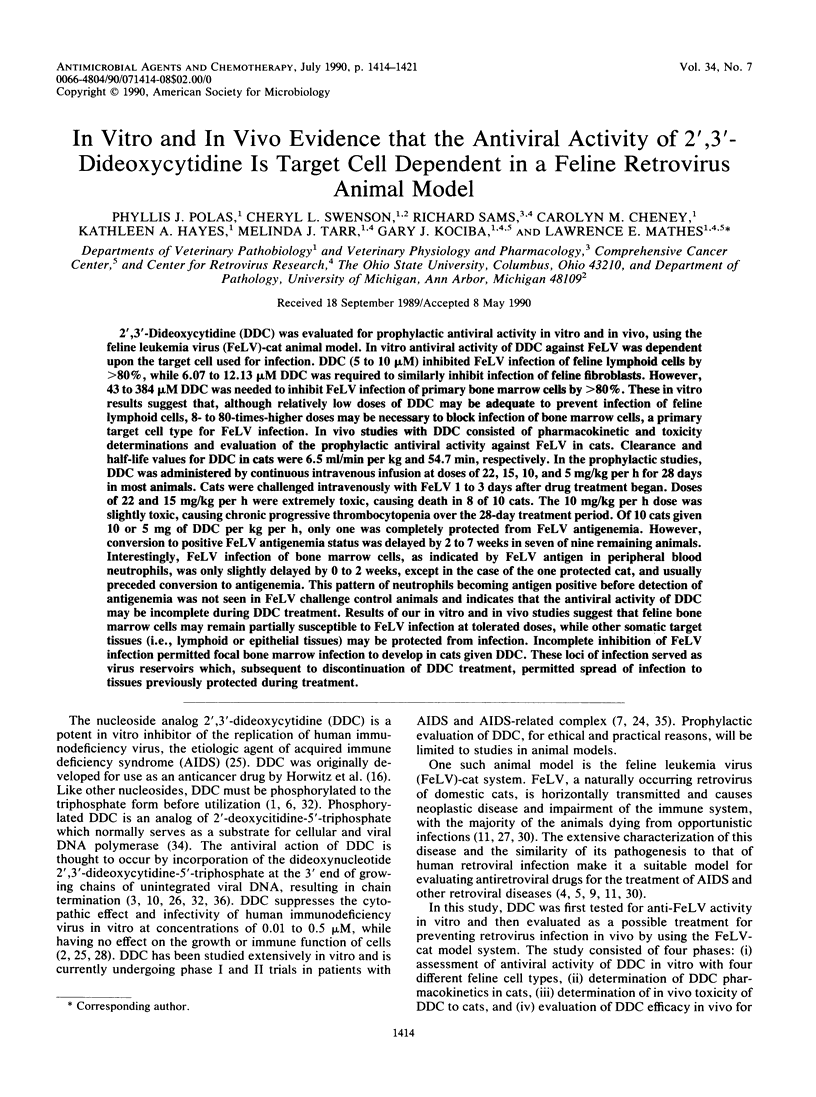
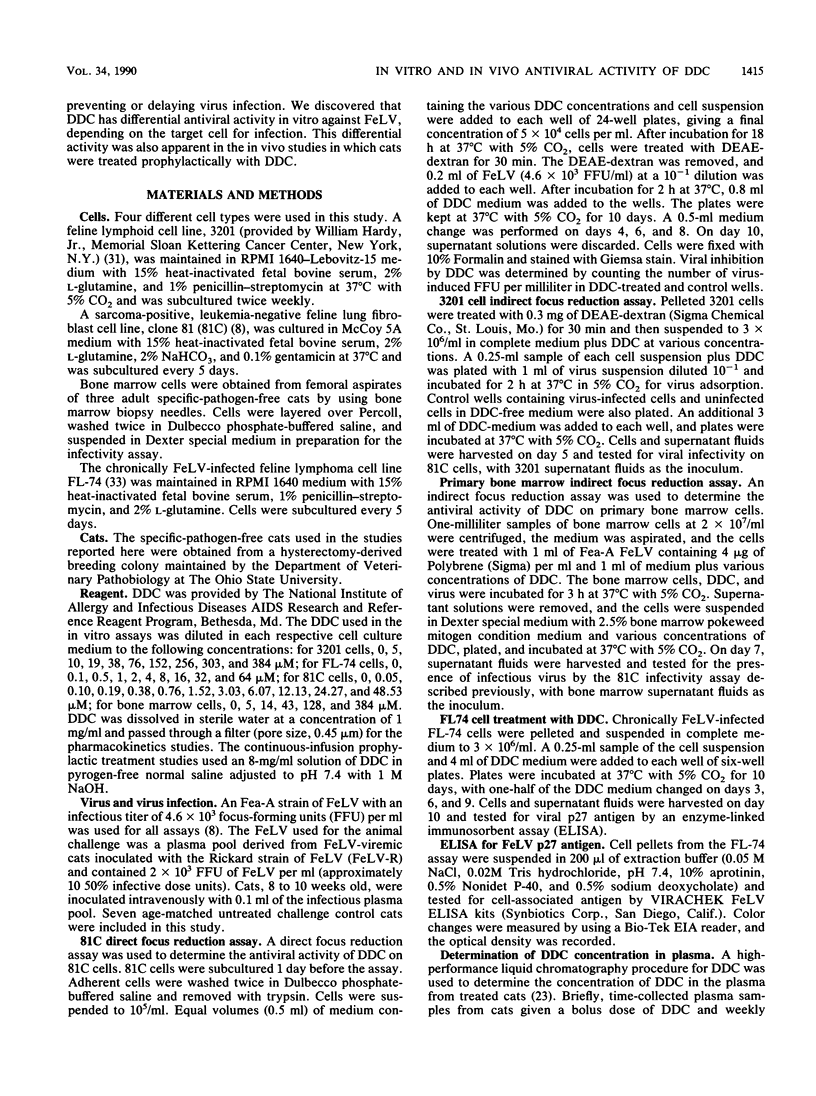
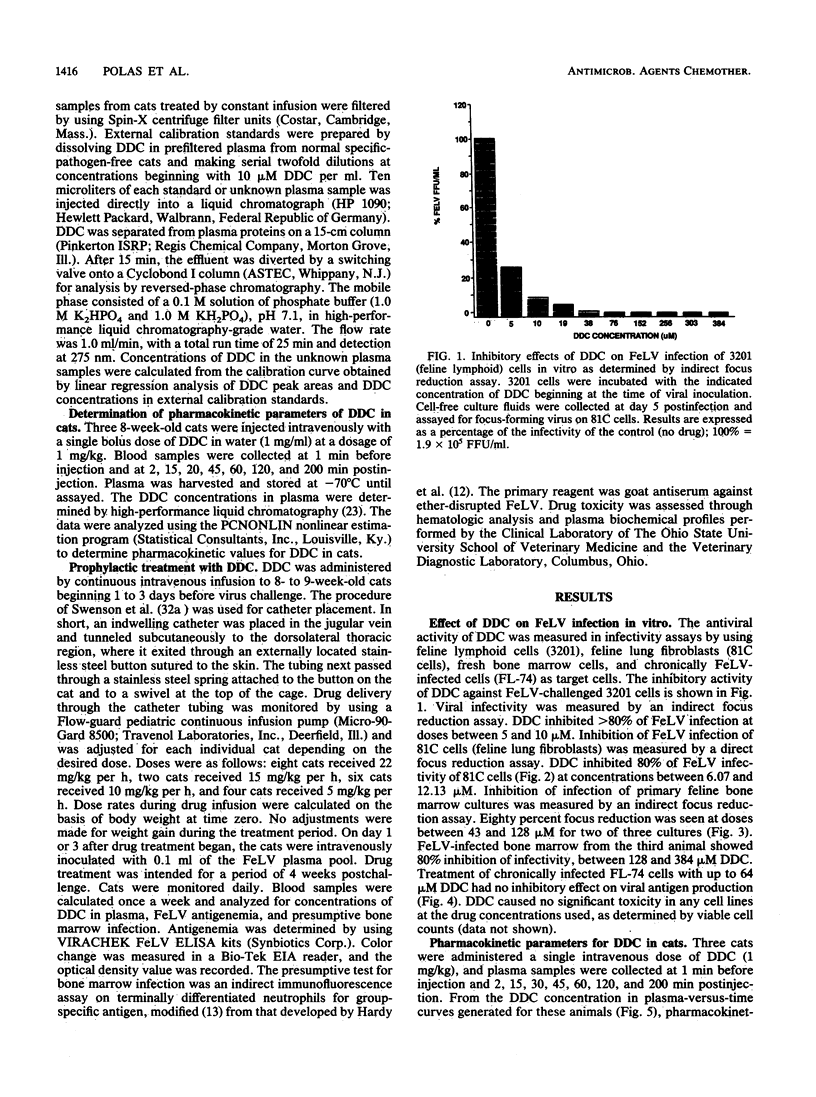

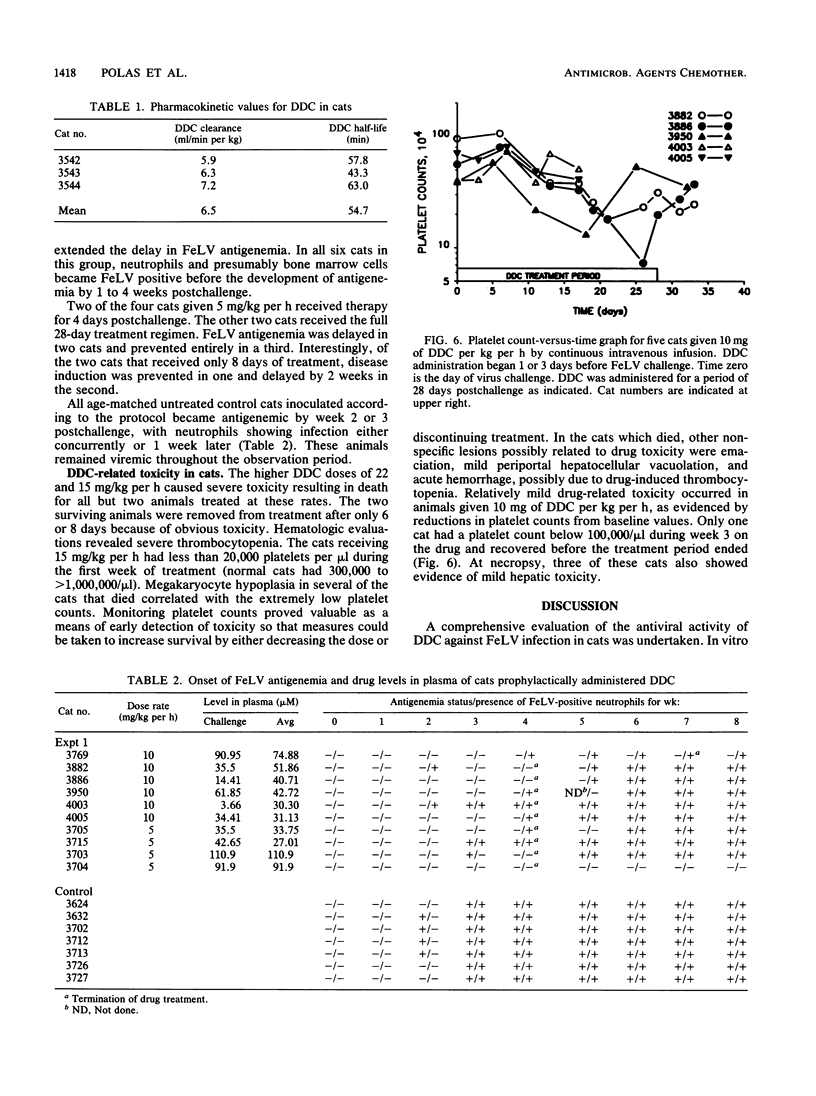
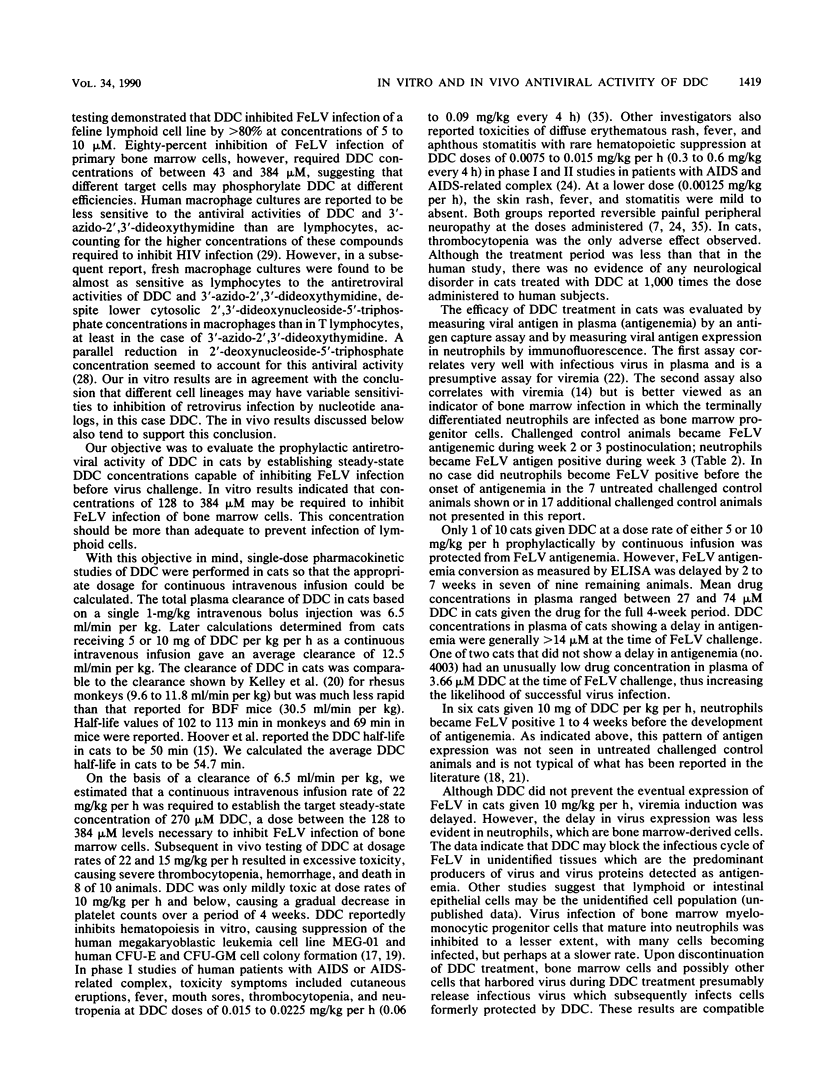
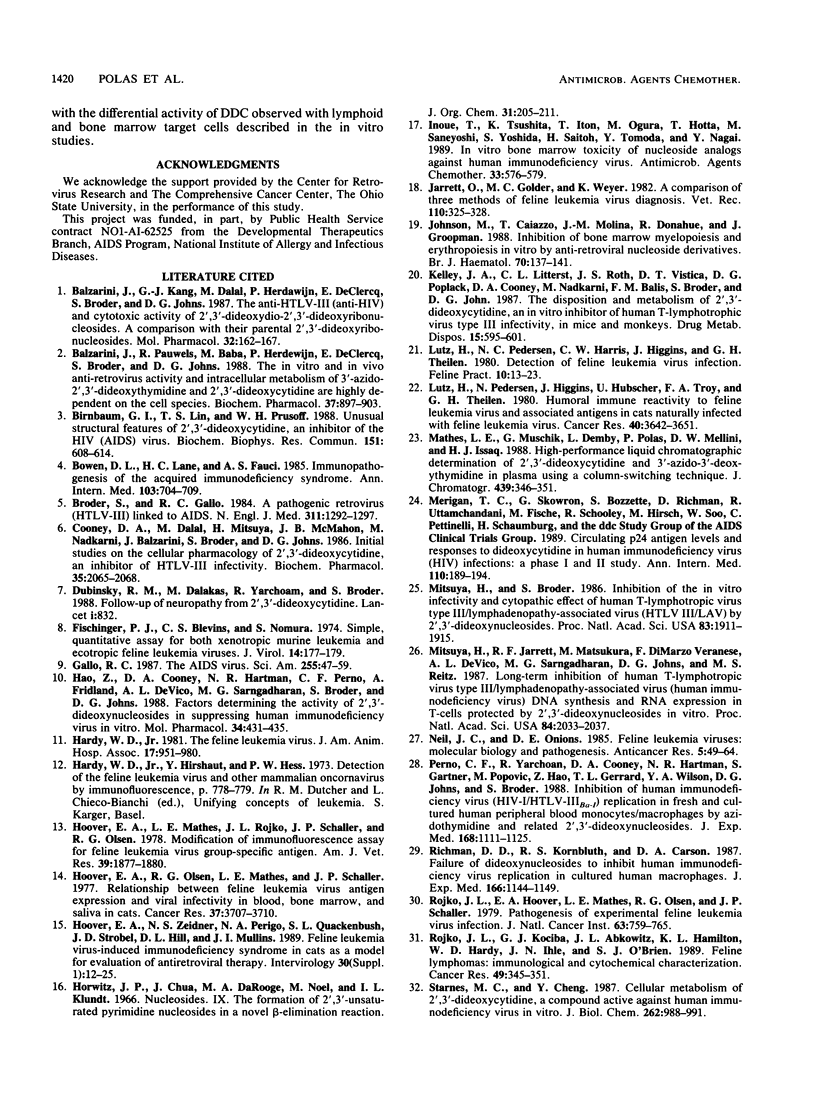
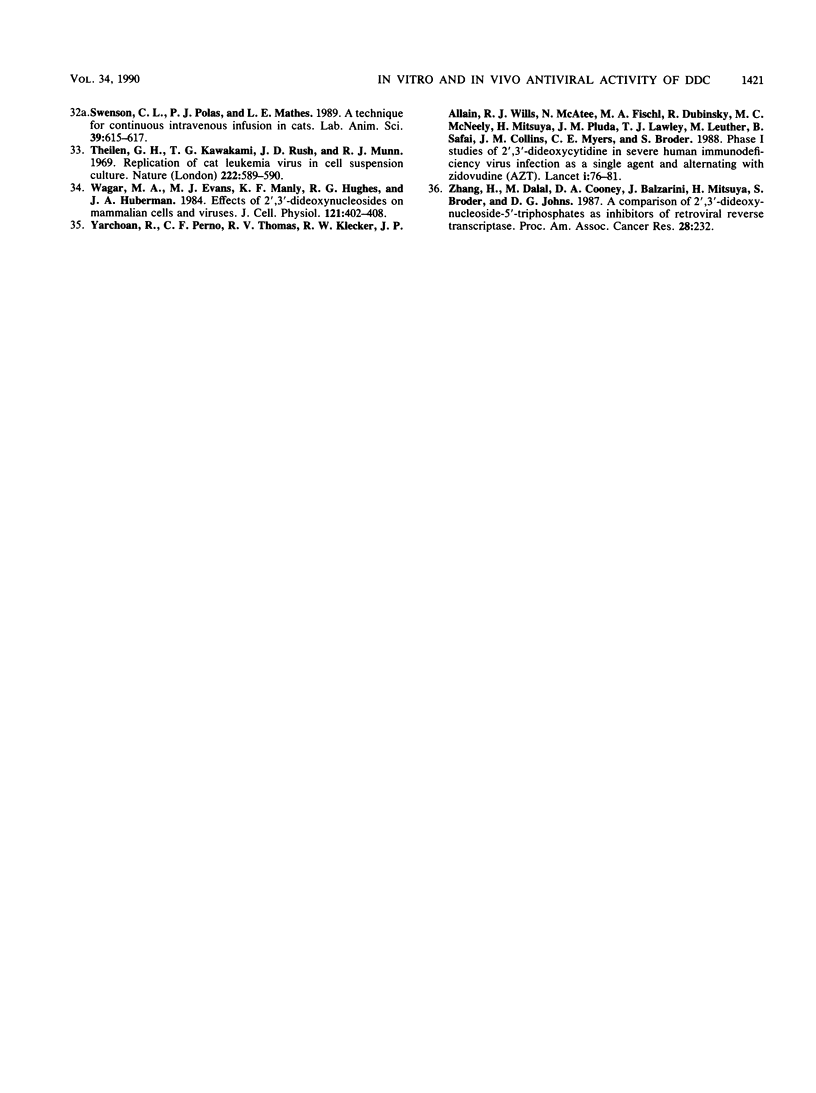
Selected References
These references are in PubMed. This may not be the complete list of references from this article.
- Balzarini J., Kang G. J., Dalal M., Herdewijn P., De Clercq E., Broder S., Johns D. G. The anti-HTLV-III (anti-HIV) and cytotoxic activity of 2',3'-didehydro-2',3'-dideoxyribonucleosides: a comparison with their parental 2',3'-dideoxyribonucleosides. Mol Pharmacol. 1987 Jul;32(1):162–167. [PubMed] [Google Scholar]
- Balzarini J., Pauwels R., Baba M., Herdewijn P., de Clercq E., Broder S., Johns D. G. The in vitro and in vivo anti-retrovirus activity, and intracellular metabolism of 3'-azido-2',3'-dideoxythymidine and 2',3'-dideoxycytidine are highly dependent on the cell species. Biochem Pharmacol. 1988 Mar 1;37(5):897–903. doi: 10.1016/0006-2952(88)90178-5. [DOI] [PubMed] [Google Scholar]
- Birnbaum G. I., Lin T. S., Prusoff W. H. Unusual structural features of 2',3'-dideoxycytidine, an inhibitor of the HIV (AIDS) virus. Biochem Biophys Res Commun. 1988 Feb 29;151(1):608–614. doi: 10.1016/0006-291x(88)90637-7. [DOI] [PubMed] [Google Scholar]
- Bowen D. L., Lane H. C., Fauci A. S. Immunopathogenesis of the acquired immunodeficiency syndrome. Ann Intern Med. 1985 Nov;103(5):704–709. doi: 10.7326/0003-4819-103-5-704. [DOI] [PubMed] [Google Scholar]
- Broder S., Gallo R. C. A pathogenic retrovirus (HTLV-III) linked to AIDS. N Engl J Med. 1984 Nov 15;311(20):1292–1297. doi: 10.1056/NEJM198411153112006. [DOI] [PubMed] [Google Scholar]
- Cooney D. A., Dalal M., Mitsuya H., McMahon J. B., Nadkarni M., Balzarini J., Broder S., Johns D. G. Initial studies on the cellular pharmacology of 2',3-dideoxycytidine, an inhibitor of HTLV-III infectivity. Biochem Pharmacol. 1986 Jul 1;35(13):2065–2068. doi: 10.1016/0006-2952(86)90571-x. [DOI] [PubMed] [Google Scholar]
- Dubinsky R. M., Dalakas M., Yarchoan R., Broder S. Follow-up of neuropathy from 2',3'-dideoxycytidine. Lancet. 1988 Apr 9;1(8589):832–832. doi: 10.1016/s0140-6736(88)91697-2. [DOI] [PubMed] [Google Scholar]
- Fischinger P. J., Blevins C. S., Nomura S. Simple, quantitative assay for both xenotropic murine leukemia and ecotropic feline leukemia viruses. J Virol. 1974 Jul;14(1):177–179. doi: 10.1128/jvi.14.1.177-179.1974. [DOI] [PMC free article] [PubMed] [Google Scholar]
- Hao Z., Cooney D. A., Hartman N. R., Perno C. F., Fridland A., DeVico A. L., Sarngadharan M. G., Broder S., Johns D. G. Factors determining the activity of 2',3'-dideoxynucleosides in suppressing human immunodeficiency virus in vitro. Mol Pharmacol. 1988 Oct;34(4):431–435. [PubMed] [Google Scholar]
- Hardy W. D., Jr, Hirshaut Y., Hess P. Detection of the feline leukemia virus and other mammalian oncornaviruses by immunofluorescence. Bibl Haematol. 1973;39:778–799. doi: 10.1159/000427906. [DOI] [PubMed] [Google Scholar]
- Hoover E. A., Mathes L. E., Rojko J. L., Schaller J. P., Olsen R. G. Modifications of the immunofluorescence assay for feline leukemia virus group-specific antigens. Am J Vet Res. 1978 Dec;39(12):1877–1880. [PubMed] [Google Scholar]
- Hoover E. A., Olsen R. G., Mathes L. E., Schaller J. P. Relationship between feline leukemia virus antigen expression and viral infectivity in blood, bone marrow, and saliva of cats. Cancer Res. 1977 Oct;37(10):3707–3710. [PubMed] [Google Scholar]
- Hoover E. A., Zeidner N. S., Perigo N. A., Quackenbush S. L., Strobel J. D., Hill D. L., Mullins J. I. Feline leukemia virus-induced immunodeficiency syndrome in cats as a model for evaluation of antiretroviral therapy. Intervirology. 1989;30 (Suppl 1):12–25. doi: 10.1159/000150120. [DOI] [PubMed] [Google Scholar]
- Horwitz J. R., Chua J., Da Rooge M. A., Noel M., Klundt I. L. Nucleosides. IX. The formation of 2',2'-unsaturated pyrimidine nucleosides via a novel beta-elimination reaction. J Org Chem. 1966 Jan;31(1):205–211. doi: 10.1021/jo01339a045. [DOI] [PubMed] [Google Scholar]
- Inoue T., Tsushita K., Itoh T., Ogura M., Hotta T., Saneyoshi M., Yoshida S., Saitoh H., Tomoda Y., Nagai Y. In vitro bone marrow toxicity of nucleoside analogs against human immunodeficiency virus. Antimicrob Agents Chemother. 1989 Apr;33(4):576–579. doi: 10.1128/aac.33.4.576. [DOI] [PMC free article] [PubMed] [Google Scholar]
- Jarrett O., Golder M. C., Weijer K. A comparison of three methods of feline leukaemia virus diagnosis. Vet Rec. 1982 Apr 3;110(14):325–328. doi: 10.1136/vr.110.14.325. [DOI] [PubMed] [Google Scholar]
- Johnson M., Caiazzo T., Molina J. M., Donahue R., Groopman J. Inhibition of bone marrow myelopoiesis and erythropoiesis in vitro by anti-retroviral nucleoside derivatives. Br J Haematol. 1988 Oct;70(2):137–141. doi: 10.1111/j.1365-2141.1988.tb02454.x. [DOI] [PubMed] [Google Scholar]
- Kelley J. A., Litterst C. L., Roth J. S., Vistica D. T., Poplack D. G., Cooney D. A., Nadkarni M., Balis F. M., Broder S., Johns D. G. The disposition and metabolism of 2',3'-dideoxycytidine, an in vitro inhibitor of human T-lymphotrophic virus type III infectivity, in mice and monkeys. Drug Metab Dispos. 1987 Sep-Oct;15(5):595–601. [PubMed] [Google Scholar]
- Lutz H., Pedersen N., Higgins J., Hübscher U., Troy F. A., Theilen G. H. Humoral immune reactivity to feline leukemia virus and associated antigens in cats naturally infected with feline leukemia virus. Cancer Res. 1980 Oct;40(10):3642–3651. [PubMed] [Google Scholar]
- Mathes L. E., Muschik G., Demby L., Polas P., Mellini D. W., Issaq H. J., Sams R. High-performance liquid chromatographic determination of 2',3'-dideoxycytidine and 3'-azido-3'-deoxythymidine in plasma using a column-switching technique. J Chromatogr. 1988 Nov 18;432:346–351. doi: 10.1016/s0378-4347(00)80664-7. [DOI] [PubMed] [Google Scholar]
- Merigan T. C., Skowron G., Bozzette S. A., Richman D., Uttamchandani R., Fischl M., Schooley R., Hirsch M., Soo W., Pettinelli C. Circulating p24 antigen levels and responses to dideoxycytidine in human immunodeficiency virus (HIV) infections. A phase I and II study. Ann Intern Med. 1989 Feb 1;110(3):189–194. doi: 10.7326/0003-4819-110-3-189. [DOI] [PubMed] [Google Scholar]
- Mitsuya H., Broder S. Inhibition of the in vitro infectivity and cytopathic effect of human T-lymphotrophic virus type III/lymphadenopathy-associated virus (HTLV-III/LAV) by 2',3'-dideoxynucleosides. Proc Natl Acad Sci U S A. 1986 Mar;83(6):1911–1915. doi: 10.1073/pnas.83.6.1911. [DOI] [PMC free article] [PubMed] [Google Scholar]
- Mitsuya H., Jarrett R. F., Matsukura M., Di Marzo Veronese F., DeVico A. L., Sarngadharan M. G., Johns D. G., Reitz M. S., Broder S. Long-term inhibition of human T-lymphotropic virus type III/lymphadenopathy-associated virus (human immunodeficiency virus) DNA synthesis and RNA expression in T cells protected by 2',3'-dideoxynucleosides in vitro. Proc Natl Acad Sci U S A. 1987 Apr;84(7):2033–2037. doi: 10.1073/pnas.84.7.2033. [DOI] [PMC free article] [PubMed] [Google Scholar]
- Neil J. C., Onions D. E. Feline leukaemia viruses: molecular biology and pathogenesis. Anticancer Res. 1985 Jan-Feb;5(1):49–63. [PubMed] [Google Scholar]
- Perno C. F., Yarchoan R., Cooney D. A., Hartman N. R., Gartner S., Popovic M., Hao Z., Gerrard T. L., Wilson Y. A., Johns D. G. Inhibition of human immunodeficiency virus (HIV-1/HTLV-IIIBa-L) replication in fresh and cultured human peripheral blood monocytes/macrophages by azidothymidine and related 2',3'-dideoxynucleosides. J Exp Med. 1988 Sep 1;168(3):1111–1125. doi: 10.1084/jem.168.3.1111. [DOI] [PMC free article] [PubMed] [Google Scholar]
- Richman D. D., Kornbluth R. S., Carson D. A. Failure of dideoxynucleosides to inhibit human immunodeficiency virus replication in cultured human macrophages. J Exp Med. 1987 Oct 1;166(4):1144–1149. doi: 10.1084/jem.166.4.1144. [DOI] [PMC free article] [PubMed] [Google Scholar]
- Rojko J. L., Hoover E. A., Mathes L. E., Olsen R. G., Schaller J. P. Pathogenesis of experimental feline leukemia virus infection. J Natl Cancer Inst. 1979 Sep;63(3):759–768. doi: 10.1093/jnci/63.3.759. [DOI] [PubMed] [Google Scholar]
- Rojko J. L., Kociba G. J., Abkowitz J. L., Hamilton K. L., Hardy W. D., Jr, Ihle J. N., O'Brien S. J. Feline lymphomas: immunological and cytochemical characterization. Cancer Res. 1989 Jan 15;49(2):345–351. [PubMed] [Google Scholar]
- Starnes M. C., Cheng Y. C. Cellular metabolism of 2',3'-dideoxycytidine, a compound active against human immunodeficiency virus in vitro. J Biol Chem. 1987 Jan 25;262(3):988–991. [PubMed] [Google Scholar]
- Swenson C. L., Polas P. J., Mathes L. E. A technique for continuous intravenous infusion in cats. Lab Anim Sci. 1989 Nov;39(6):615–617. [PubMed] [Google Scholar]
- Theilen G. H., Kawakami T. G., Rush J. D., Munn R. J. Replication of cat leukemia virus in cell suspension cultures. Nature. 1969 May 10;222(5193):589–590. doi: 10.1038/222589b0. [DOI] [PubMed] [Google Scholar]
- Waqar M. A., Evans M. J., Manly K. F., Hughes R. G., Huberman J. A. Effects of 2',3'-dideoxynucleosides on mammalian cells and viruses. J Cell Physiol. 1984 Nov;121(2):402–408. doi: 10.1002/jcp.1041210218. [DOI] [PubMed] [Google Scholar]
- Yarchoan R., Perno C. F., Thomas R. V., Klecker R. W., Allain J. P., Wills R. J., McAtee N., Fischl M. A., Dubinsky R., McNeely M. C. Phase I studies of 2',3'-dideoxycytidine in severe human immunodeficiency virus infection as a single agent and alternating with zidovudine (AZT). Lancet. 1988 Jan 16;1(8577):76–81. doi: 10.1016/s0140-6736(88)90283-8. [DOI] [PubMed] [Google Scholar]


